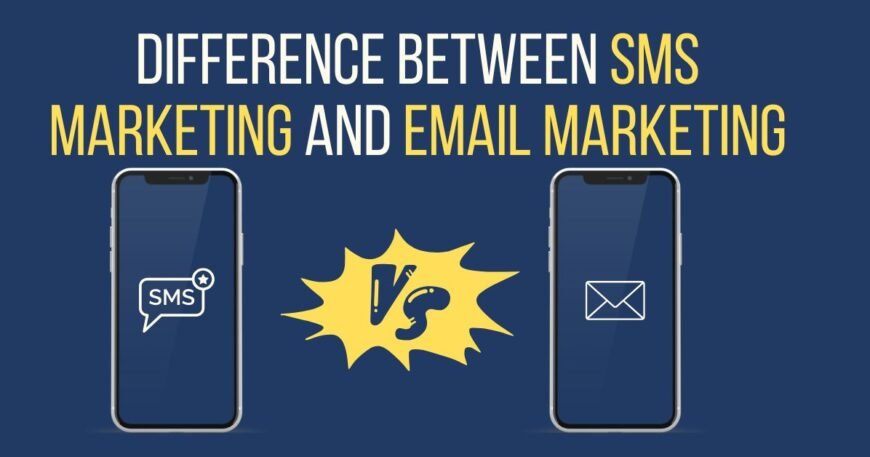The Difference Between SMS Marketing and Email Marketing
In today’s digital landscape, businesses have a myriad of marketing channels at their disposal. Two of the most effective methods are SMS marketing and email marketing. While both can generate strong engagement and drive conversions, they operate in distinct ways and have unique advantages. Understanding these differences is essential for any marketing strategy.
What is SMS Marketing?
SMS marketing involves sending promotional messages via text messages (SMS) directly to customers’ mobile phones. This method leverages the high open rates of SMS, which hover around 98%, making it one of the most effective communication channels for reaching audiences swiftly and effectively.
Advantages of SMS Marketing
-
Instant Communication: SMS messages are typically read within minutes of being received, allowing businesses to communicate time-sensitive offers or alerts.
-
High Engagement Rates: With an open rate of about 98%, SMS marketing offers vastly superior engagement compared to many other marketing channels.
-
Accessibility: Since virtually everyone has a mobile phone, SMS marketing can reach a broader audience across demographics.
-
Concise Messaging: SMS encourages brevity, forcing marketers to create direct and impactful messages.
-
Cost-Effective: With lower costs per message compared to other forms of advertising, businesses can achieve high ROI from SMS campaigns.
What is Email Marketing?
Email marketing entails sending targeted emails to a list of contacts who have opted in to receive communications from a business. This strategy is commonly used to share newsletters, product announcements, and promotional offers.
Advantages of Email Marketing
-
Rich Content: Emails allow for longer, more detailed content inclusion such as images, graphics, and links, which can enhance storytelling and brand messaging.
-
Segmentation and Personalization: Email marketing platforms enable businesses to segment their audience based on behavior, preferences, and demographics, allowing for highly personalized communication.
-
Analytics and Tracking: Email marketing tools often provide robust analytics, enabling businesses to track open rates, click-through rates, and conversions.
-
Cost-Effective for Larger Audiences: Once the initial set-up is completed, sending emails to a large number of subscribers can be very cost-efficient.
-
Automation: Email marketing allows for automated sequences, such as welcome series or abandoned cart reminders, improving user experience without additional effort.
Key Differences Between SMS and Email Marketing
1. Reach and Accessibility
- SMS Marketing: Reaches customers instantly on their mobile devices, making it particularly effective for time-sensitive promotions.
- Email Marketing: While it can reach a large audience, emails may not be checked as frequently as text messages.
2. Content Length and Format
- SMS Marketing: Limited to 160 characters, requiring starkly concise messages.
- Email Marketing: Unrestricted in length, allowing for rich content and detailed information.
3. User Engagement
- SMS Marketing: High open rates but can be perceived as intrusive if overused.
- Email Marketing: Lower open rates compared to SMS but allows for deeper engagement through storytelling and information.
4. Cost Effectiveness
- SMS Marketing: Costs associated with per message sent can add up for large campaigns.
- Email Marketing: Often more cost-efficient for larger outreach due to lower per-outreach costs.
5. Opt-In Process
- SMS Marketing: Generally requires explicit consent, and users must opt-in specifically for SMS communications.
- Email Marketing: While opt-in is also necessary, users may more readily provide their emails due to the prevalence of email subscriptions.
Which One Should You Choose?
The best approach often involves a combination of both SMS and email marketing. Integrating both methods can help maximize outreach and engagement.
When to Use SMS Marketing
- For time-sensitive promotions, flash sales, or urgent updates.
- When targeting a younger audience that frequently uses mobile devices.
When to Use Email Marketing
- For in-depth content sharing, newsletters, and longer-form communication.
- When building relationships and providing regular updates to your audience.
Conclusion
In summary, both SMS marketing and email marketing are powerful tools in the digital marketer’s arsenal. By understanding their differences, businesses can craft effective strategies that leverage the strengths of each method. Whether you’re looking for immediate impact with SMS or nurturing relationships through email, the key is to choose the right channel for your specific marketing goals.
By integrating both methods wisely, businesses can not only enhance customer engagement but also drive successful marketing outcomes.





